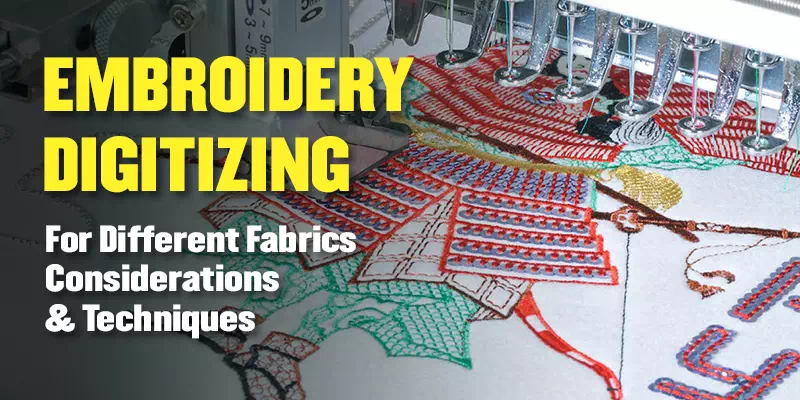Embroidery is an art that transforms fabric into captivating designs, but the magic doesn’t stop with just the threads and needles. The fabric you choose plays a crucial role in how the design comes to life.
Well! Embroidery is like creating beautiful art on fabric using threads. But picking the right fabric is like choosing the right canvas for a painting. We’ll explore why fabric matters and how the embroidery digitizing helps the design fit perfectly on the fabric.
Imagine a magical dance of colors and textures, that’s what we’ll learn about! So, let’s unravel the secrets behind embroidery digitizing for fabrics.
Understanding Fabric Variability
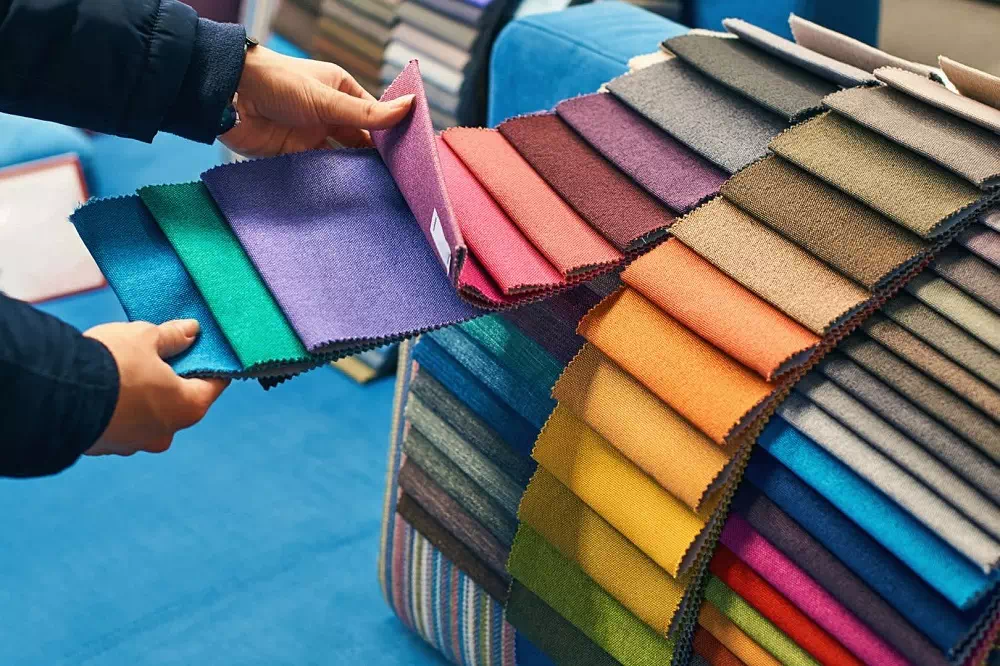
Fabrics are like a team of unique players, each with their own strengths and characteristics. Let’s discover how these different fabrics can bring out the best in embroidered designs.
Diverse Fabric Types for Embroidery
Fabrics are like a team of players with different skills. We have natural fabrics like cotton, linen, and silk, and also synthetic ones like polyester and nylon. Blended fabrics mix different materials, like cotton-polyester.
Natural Fabrics: Nature offers us some fantastic options. We have natural fabrics like soft cotton, classy linen, and luxurious silk. Each one brings a unique touch to the artwork, making the embroidery experience even more special.
Synthetic Fabrics: Synthetic fabrics are like the modern superheroes of embroidery. They include materials like polyester and nylon, which have special qualities that can enhance your embroidered designs.
Blended Fabrics: Blended fabrics are like a mix of different flavors in a dish – they create something unique and exciting. These fabrics, such as cotton-polyester blends, combine the best of both natural and synthetic worlds. They offer comfort, durability, and versatility, making them a great canvas for your embroidered creations.
Suggested Article- Best Embroidery Machines for Custom Designs.
Fabric Impact on Embroidery Aesthetics
When fabrics and embroidery come together, they create a beautiful visual story. This story is made up of two main chapters:
Texture and Surface Variation: Fabrics have different textures – some are smooth like a calm lake, while others might be bumpy like a cobblestone path. When you embroider these fabrics, the texture adds depth and character to the design, making it feel alive.
Reflecting Light and Color: Imagine fabric as a mirror that reflects light in unique ways. Depending on the fabric’s properties, it can make colors shine differently. Embroidery on these fabrics becomes like painting with light, creating eye-catching effects that mesmerize the viewer.
Fabric Challenges and Opportunities
Embroidering on different fabrics is like a thrilling adventure with challenges and rewards. Let’s explore two challenges in embroidery digitizing for fabrics:
Elasticity and Stretchability: Some fabrics are stretchy, like a rubber band. Embroidering on them can be a bit tricky because they move and stretch. But this challenge also brings opportunities to create dynamic and flexible designs that move with the fabric.
Thick and Thin Fabrics: Fabrics vary in thickness – some are thick like a cozy blanket, while others are thin like a delicate veil. Embroidering on these different fabrics requires adapting techniques. Thick fabrics offer a robust base, allowing for bold designs, while thin fabrics require delicate embroidery to maintain their elegance. It’s like painting on different canvases – each requires a unique approach.
You may also read– How to Optimize Designs for Embroidery.
Considerations for Embroidery on Different Fabrics
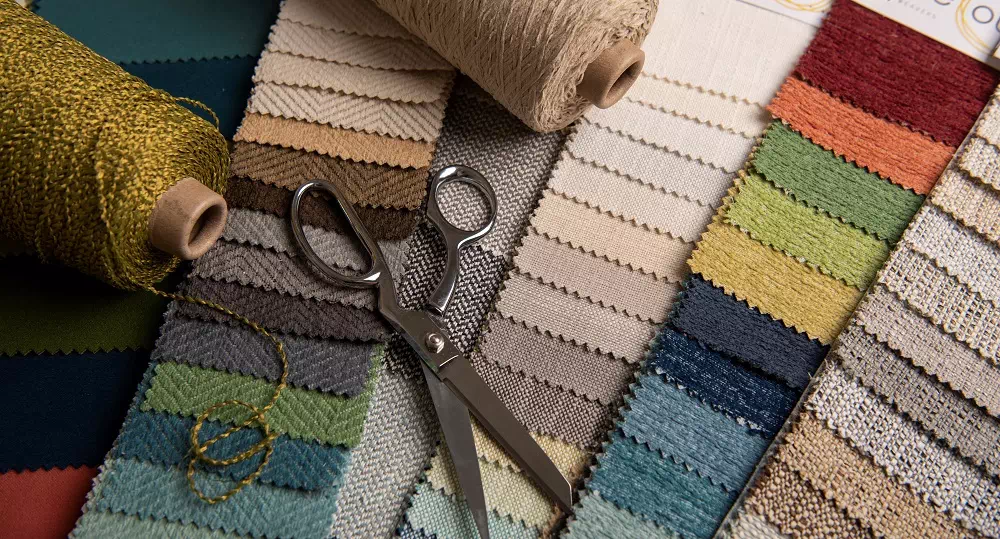
Embroidery is like a dance between threads and fabrics, and these considerations are the steps to a graceful performance. They help you to be professional in embroidery digitizing for fabrics.
Selection of suitable fabrics for embroidery: Just like choosing the right dance partner, selecting the perfect fabric is crucial. Some fabrics are more embroidery-friendly than others. Consider factors like fabric type, texture, and thickness to ensure a harmonious match.
Matching fabric characteristics with design elements: Think of your design as the choreography of the dance. It’s important to match the fabric’s qualities with the design’s intricacies. For example, a delicate design might shine on a smooth fabric, while a bold design could stand out on a textured one.
Evaluating fabric stretch and stability: Fabrics have their own rhythm – some are stretchy like elastic bands, while others stay steady like a rock. Before embroidering, understand how the fabric moves. This helps you create designs that flow with the fabric’s movement or stay firm if needed.
Exploring Versatile Embroidery Approaches on Different Fabrics
Discovering the magic of embroidery on different fabrics is like exploring a whole new world of creativity. Let’s dive into the exciting techniques of embroidery digitizing for fabrics.
Stitch Type and Density Considerations: Think of stitches as your brush strokes, each creating a unique texture. Here are two techniques to master:
Balancing Stitch Density for Different Fabrics: Think of stitch density like how much thread is used in each stitch. It’s like using different amounts of paint when you’re drawing. For light fabrics, we use less thread, like gentle strokes. For heavy fabrics, we use more thread, like bold strokes. It’s about getting the right balance so our embroidery looks great on any type of fabric.
Selecting Stitch Types for Texture Enhancement: Imagine stitch types as different patterns your thread can make. Just like how different brushes create different textures in art, selecting stitch types for texture enhancement is like choosing the right brushstroke. Some stitches make your design look bumpy, while others make it smooth. It’s like adding extra magic to your embroidery to make it feel special and unique.
Adjusting Underlay Stitches for Stability: Think of underlay stitches as the foundation of your embroidery. Adjusting them for stability means making sure this foundation is strong and fits the fabric perfectly. It keeps your design secure and looking great, just like a strong base for a building.
Impact of Underlay on Different Fabrics: Underlay stitches are like a foundation for your embroidery. They help stabilize different fabrics, ensuring your design looks great on all types.
Techniques for Stable Embroidery on Elastic Fabrics: Elastic fabrics are like stretchy superheroes. Using the right techniques, like adjusting underlay stitches, helps keep your embroidery steady and vibrant, even on these flexible materials.
Suggested Article- Best Embroidery Digitizing Software.
Color and Thread Considerations
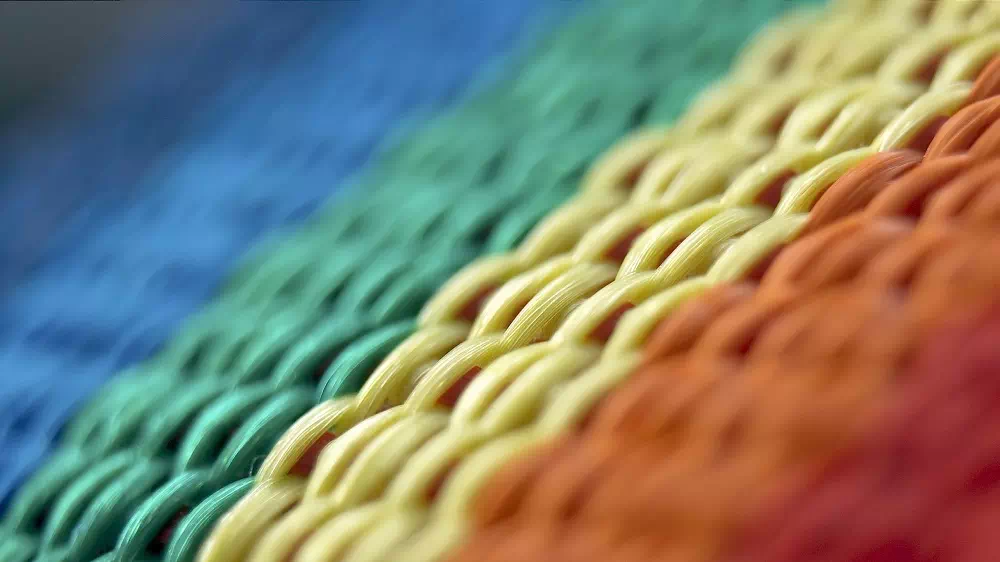
Choosing the right colors and threads for embroidery is like selecting the perfect palette to bring your designs to life. Let’s delve into the art of color and thread choices for vibrant and captivating embroidery creations.
Importance of Color Matching: Color matching is like picking the right ingredients for a recipe. When you use thread colors that match the fabric’s colors, your design looks amazing.
Harmonizing Thread Colors with Fabric Hues: Harmonizing thread colors with fabric hues is like creating a beautiful blend of colors. Choosing thread shades that match the fabric’s colors enhances your design and makes it visually appealing.
Preventing Color Bleeding on Certain Fabrics: Preventing color bleeding on certain fabrics means stopping colors from spreading and mixing together. Some fabrics are more likely to have colors bleed into each other. Using the right methods and testing can stop this from happening, so your embroidery stays neat and tidy.
Color Variation on Different Materials: Color variation on different materials refers to how colors can look different on various fabrics. Natural fabrics like cotton might show colors one way, while synthetic fabrics like polyester could make them appear differently. Understanding these variations helps you pick the right colors to make your embroidery pop on each fabric type.
Vibrancy on Natural vs. Synthetic Fabrics: Natural fabrics like cotton and silk may make colors appear softer and more muted, while synthetic fabrics like polyester can enhance color vibrancy. Choosing the right fabric can impact how vivid and eye-catching your embroidery will be.
Subtle Color Effects on Textured Fabrics: Textured fabrics, such as woven or knitted materials, can create subtle variations in color due to the way they reflect light. These variations add depth and dimension to your embroidery, making it visually captivating and unique.
Design Adaptation and Placement
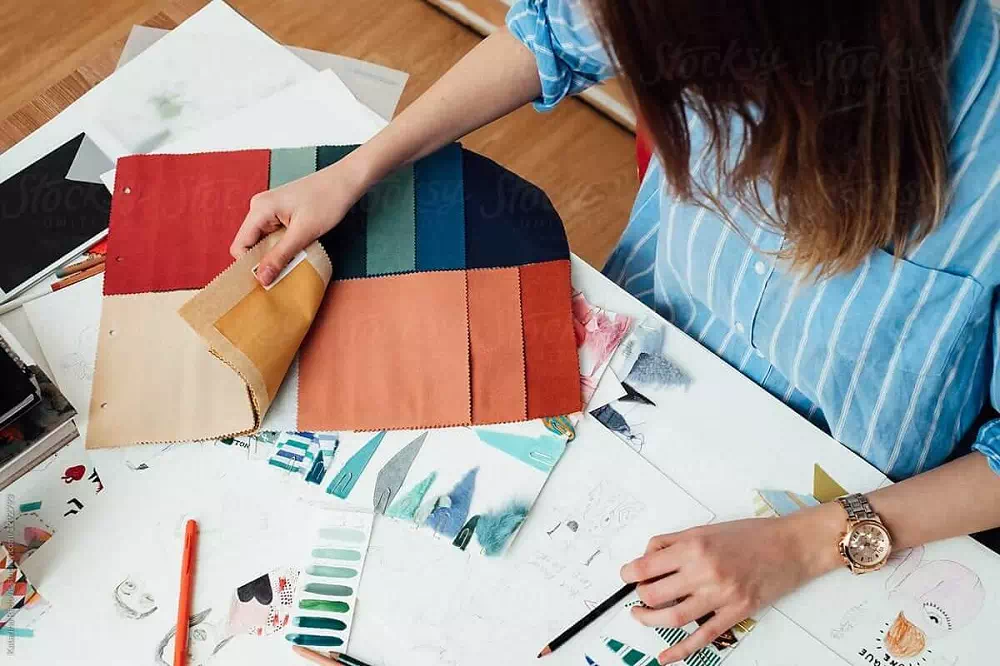
Crafting designs to fit different fabrics and placing them right is like finding the perfect frame for a masterpiece, ensuring each stitch enhances the fabric’s beauty.
Simplifying Complex Designs for Delicate Fabrics: Delicate fabrics are like fine paper, and complex designs might be too heavy for them. So, it’s like using a lighter brush for delicate strokes. Making designs simpler helps them look stunning on these fabrics.
Enhancing Design Visibility on Heavy Fabrics: Heavy fabrics can hide details like a cloudy sky hiding the stars. To make designs shine, we use thicker threads and stitches, so they pop out. It’s like using a bright spotlight to show the stars on a cloudy night.
Design Placement Considerations: It’s like choosing the best spot for a painting. Placing designs correctly on fabrics matters. Adjusting stitch lengths and densities is like changing brush strokes for different parts. Also, using flat areas on thicker fabrics is like using a smooth canvas. This ensures your design looks perfect on any fabric.
Strategic Design Placement
Strategic design placement involves carefully choosing where to put your embroidery on different fabrics. This ensures that the design looks its best and stays in the right shape over time. It’s like finding the perfect spot for a beautiful painting in a room. This placement is a very important part in embroidery digitizing for fabrics.
Avoiding Stretch Areas on Elastic Fabrics: When working with fabrics that can stretch, it’s important to avoid placing your embroidery in areas that are prone to stretching. This helps prevent the design from getting distorted when the fabric stretches.
Just like how a rubber band can change shape when pulled, elastic fabrics can stretch and change the way your design looks. By avoiding these stretchy areas, your embroidery will stay true to its intended shape and last longer.
Utilizing Flat Surfaces on Thicker Fabrics: Thicker fabrics, like denim or canvas, often have flat surfaces that don’t stretch as much. These flat areas are perfect for embroidery placement. It’s like painting on a sturdy canvas instead of a flexible one. This technique ensures that your embroidery stands out with a strong visual impact and looks its best on thicker materials.
Exploring Fabric-Specific Embroidery Tips
Embroidering on various fabrics is like exploring a world of possibilities. Here are some specialized tips that bring out the best in different materials:
Satin Stitching on Silks and Satins: Satin stitches add a touch of luxury to delicate fabrics like silk and satin. These smooth and shiny stitches create an elegant look, enhancing the fabric’s inherent beauty.
Embossing Effects on Leather and Denim: Leather and denim offer a rugged canvas for embroidery. Embossing techniques create textured designs that stand out on these durable materials, showcasing creativity and artistry.
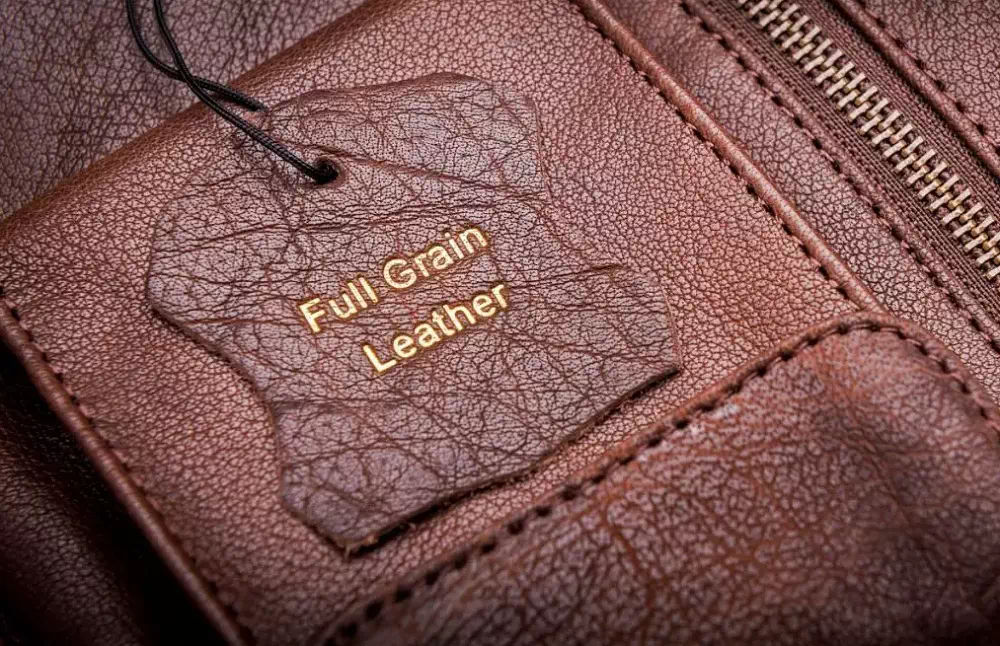
Stretch-Friendly Stitches on Knits: Elastic knits demand stitches that move with the fabric. Use stretch-friendly stitches like zigzag or cover stitches on knitted fabrics to maintain flexibility without compromising the design.
Layering Threads for Depth: Fabrics with texture, such as corduroy or tweed, can be elevated with layered embroidery threads. These layers add depth and dimension, enhancing the tactile and visual appeal.
Chenille Embroidery on Wool: Chenille embroidery creates a fuzzy, textured effect that works wonders on wool fabrics. This technique adds warmth and character to your designs, perfect for cozy apparel.
Lace-Like Detailing on Sheer Fabrics: Sheer fabrics like organza can be adorned with delicate lace-like embroidery. Light, open stitches add an airy charm, allowing the fabric’s translucency to shine through.
Sequins and Beads on Evening Wear: Evening wear fabrics like tulle or chiffon can be embellished with sequins and beads. These sparkling accents create a glamorous look fit for special occasions.
Cross-Stitching on Aida Cloth: Aida cloth’s grid-like structure makes it ideal for cross-stitch embroidery. Use this technique to create intricate designs with a timeless, handmade appeal.
Whimsical Appliqué on Cotton: Cotton fabrics are perfect for appliqué embroidery. Combine different fabric pieces to create playful and whimsical designs that pop on clothing and accessories.
Metallic Thread Magic: Metallic threads bring a touch of dazzle to any fabric. Use them to add shimmering accents to your embroidery, making your designs truly eye-catching.
Test Runs and Refinements

Embroidery is an art that requires careful attention to detail. Here’s how the test runs and refinements can help you achieve embroidery excellence on various fabrics:
Significance of Test Runs on Various Fabrics: Test runs are like practice sessions for your embroidery masterpiece. They allow you to evaluate stitch quality and how well your design interacts with different fabrics. Different fabrics behave differently. Test runs help you fine-tune stitch settings to ensure they look impeccable and complement the fabric’s characteristics.
Test runs act as your troubleshooting phase. They reveal potential challenges like puckering, distortion, or thread tension issues, allowing you to address them before the final embroidery.
Iterative Adjustments for Perfect Fabric Embellishment: Think of test runs as your creative playground. You can experiment with stitch types, densities, and thread colors iteratively until you achieve the perfect embellishment for the fabric.
Expert Insights and Trends
Embroidery is a dynamic field, always evolving to meet new challenges and opportunities. Here’s a glimpse into the expert insights and trends that can guide your fabric digitizing journey:
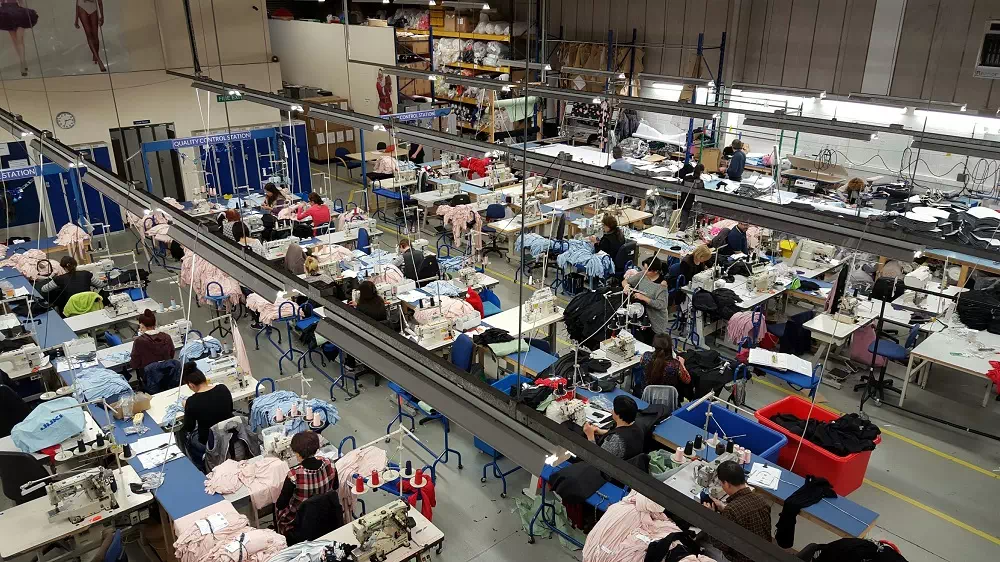
Industry Expert Perspectives on Fabric Digitizing: Experts who know a lot about embroidery share their advice. It’s like having a map to help you find your way through the fabric world.
Emerging Techniques for Challenging Fabrics: Some fabrics are tricky, but experts are finding new ways to work with them. It’s like discovering new tools to solve puzzles and make your designs look amazing.
Staying Updated with Fabric Embroidery Trends: Trends are like the latest cool things everyone likes. Knowing what’s trendy helps your designs feel fresh and interesting.
Suggested Article- Crewel Embroidery.
To Conclude
Embroidery is like painting on fabric, creating beautiful designs that tell stories. In this journey, we’ve learned how to choose fabrics, match colors, and use techniques that make designs shine. We’ve explored how to work with different fabrics, adapting designs to each one. It’s like learning how to dance with different partners, making every design look its best.
Turning fabrics into stunning embroidered art is a journey of creativity and skill. By understanding different fabric types, adapting designs, and using specialized techniques, you can transform plain materials into captivating works of art.
With each stitch and thread, you have the power to breathe life into the fabric, creating unique and enchanting pieces that showcase your creativity and expertise. Embrace the magic of embroidery and let fabrics become your canvas for crafting beautiful artistry that speaks to the heart and imagination.


